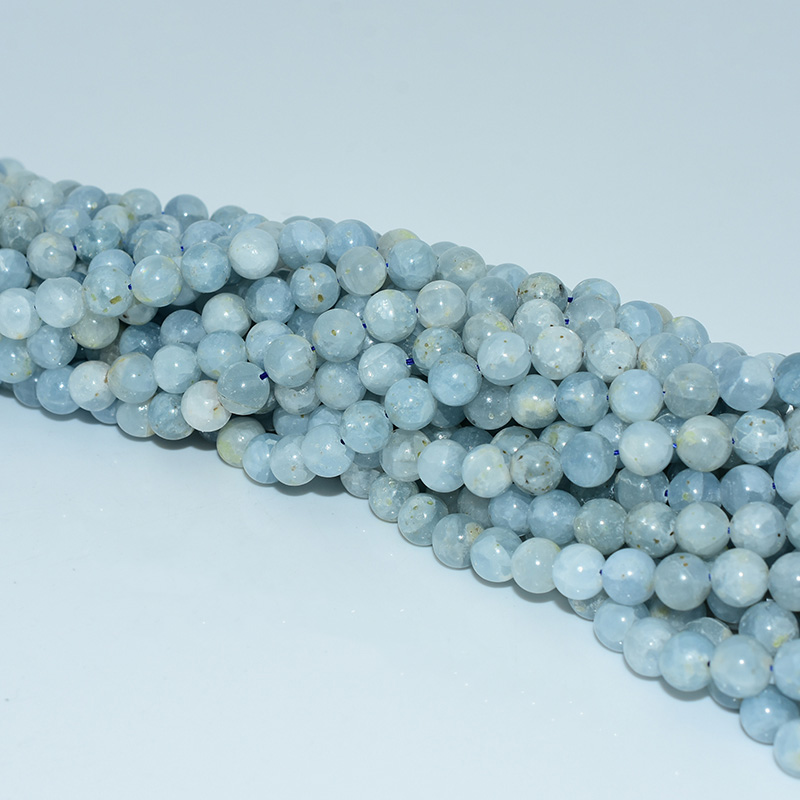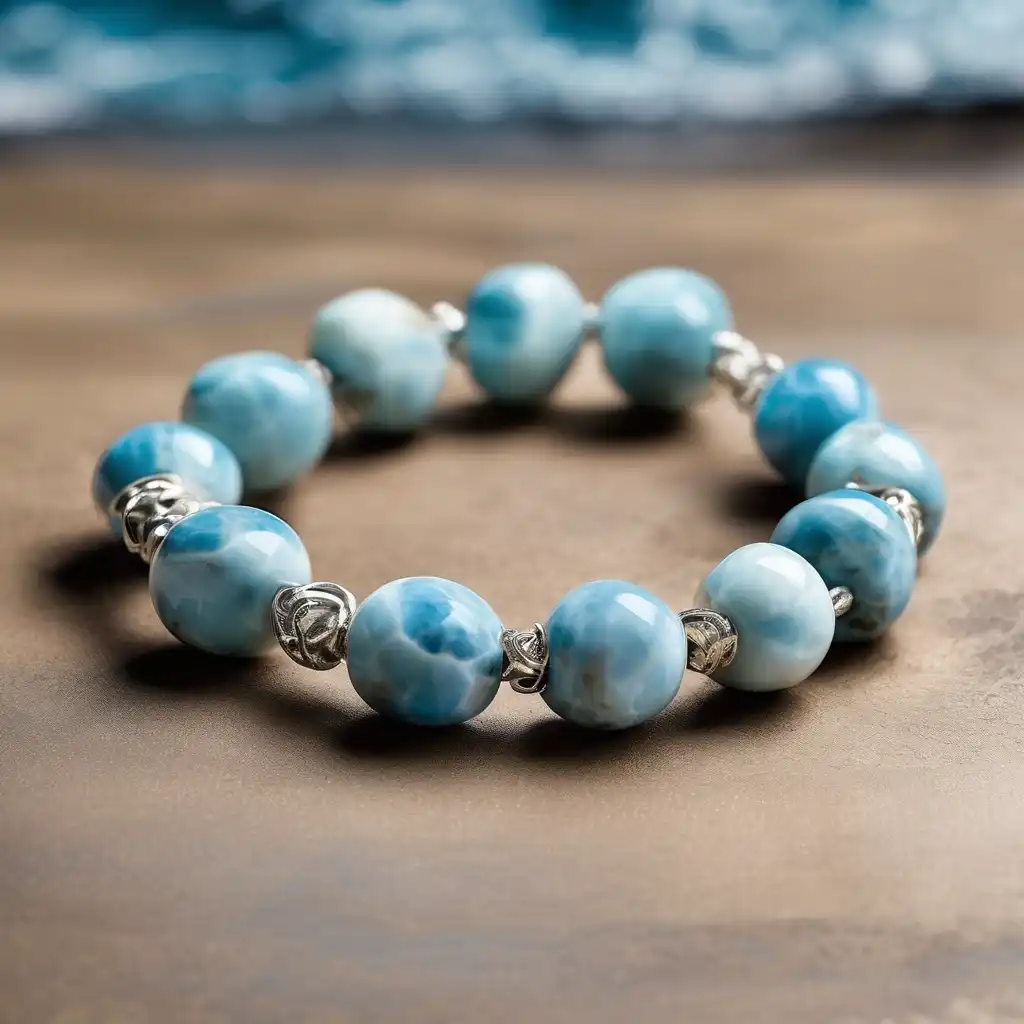Celestite vs Angelite: A Clear-Cut Guide to Two Heavenly Blues
Are Angelite and Celestite the Same Thing?
At first glance, Celestite vs Angelite can feel like a single entry on a crystal-shop shelf: both display dreamy shades of sky blue and sit neatly beside incense and tarot decks. Yet when collectors dig deeper—or simply hold the stones side by side—the question of Celestite vs Angelite becomes a miniature geology lesson. One stone sparkles like frozen sea spray; the other glows with a muted, powder-blue calm. That visual contrast hints at equally distinct chemical, structural, and energetic profiles.
What Is Celestite in English?
Celestite—also spelled celestine—derives from the Latin caelestis, meaning “heavenly.” The name suits its subtle radiance: polished palm stones seem to harbor their own inner dawn. Scientifically, celestite is strontium sulfate (SrSO₄), an orthorhombic sulfate mineral often found in sedimentary or marine environments. Madagascar remains the celebrity source, but rich pockets also arise in Ohio geodes, Mexican deserts, and Brazilian limestone beds. Transparent to translucent, celestite fractures easily, so cutters favor gentle cabochons or clusters that preserve its natural geometry.
What Is the Scientific Name for Celestite?
The formal tag is simply “strontium sulfate,” but gem dealers keep the poetic “celestite” because it captures the stone’s airy vibe. Under a loupe, its sharply edged crystals exhibit a glassy, almost watery luster. That translucence makes pieces seem lighter than they are—yet a cluster can surprise you with heft, thanks to dense strontium atoms locked inside each lattice.
Angelite: Not Just a Pretty Name
Angelite is the trade name for a blue variety of anhydrite, a calcium sulfate (CaSO₄) that forms when water evaporates from massive beds of gypsum. Discovered in commercial quantities only a few decades ago—most famously in the Peruvian Andes—Angelite feels chalkier than its strontium cousin. It seldom produces discrete crystals; instead, miners extract huge, solid chunks that lapidaries slice into spheres, beads, or free-form “cloud stones.” The surface polishes to a gentle matte rather than a high gloss, inviting fingers to linger.
Chemically, Angelite is literally “thirsty”: add water and it rehydrates back to gypsum. That fragility explains why Angelite pendants develop tiny pits if worn in the shower, while Celestite specimens mainly risk chipping rather than dissolving. Still, both rank around 3–3.5 on the Mohs scale, which places them below a steel nail and only a shade above a fingernail—handle with care.
Celestite vs Angelite: The Big Picture
Feature Celestite (SrSO₄)Angelite (CaSO₄)Crystal System Orthorhombic, tabular, or prismatic Monoclinic, massive, or granular Transparency/Luster Transparent-to-translucent, glassy Opaque, velvety, or matte Typical Hue Sky blue, sometimes colorless or pale yellow Powder blue to blue-gray Solubility Slightly water-soluble Readily rehydrates to gypsum Main Localities Madagascar, USA, Mexico, Brazil Peru, minor finds elsewhere Metaphysical Focus Angelic communication, clarity Peace, empathy, gentle grounding.
Why, then, do beginners confuse the two? Lighting is part of the riddle: under warm indoor bulbs, the glassy flashes of celestite can mute, while angelite’s soft matte subtly brightens, blending their blues. Social media captions add to the chaos—one viral photo labeled “raw Angelite” was actually a pocket of Celestite geodes from Sakoany, Madagascar. When you read Celestite vs Angelite debates online, notice how quickly commenters pivot to metaphysical feel: Celestite “lifts you upward,” they say, whereas Angelite “wraps you in a blanket.” Once you experience the stones personally, the color similarity diminishes.
Ultimately, treating Celestite vs Angelite as interchangeable shortchanges both. Celestite’s strontium-rich sparkle evokes open skies and crisp insight; Angelite’s calcium-soft hush calms nerves and invites compassionate listening. Collectors happily keep both on the same shelf—but for different moods, different meditations, and different jewelry designs. If you remember only one tip, remember the luster test: Celestite flashes light like the sun on water, while Angelite glows the way clouds look moments before dusk.
By recognizing those hallmarks, you’ll never again have to ask friends, “Is this celestite or angelite?” —you’ll know at a glance, and the conversation can move to the more intriguing territory of how each stone speaks to the heart.
Is Angelite Compressed Celestite? The Science Behind Their Formation
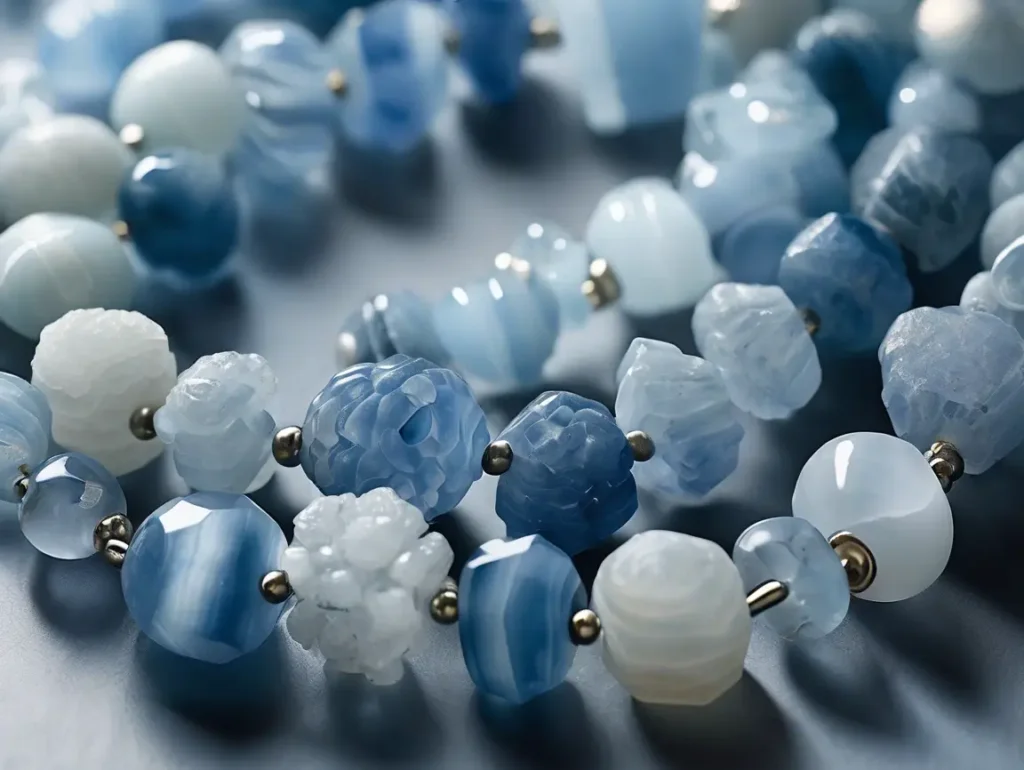
The rumor that Angelite is “compressed Celestite” pops up in every gem-market chat group, yet a quick dive into hard geology shows the idea simply doesn’t fit. Celestite vs Angelite is not a story of one stone squeezing itself into a new identity; it’s the tale of two minerals that start life in completely different environments and keep their own personalities to the end.
Celestite grows where ancient seas once sloshed, dripping strontium into hollows and cavities until orthorhombic crystals bloom like icy flowers. Angelite, meanwhile, begins as ordinary gypsum in an evaporating basin. Heat and time drive out the water, leaving behind a massive, chalk-blue anhydrite that never forms crystal faces.
Pressure plays only a cameo role—certainly not the starring transformation the myth suggests. That alone should settle the question, yet the Celestite vs Angelite comparison doesn’t end at the earth’s crust.
Formation Environments: Celestite vs Angelite
Imagine celestite geodes in Madagascar or limestone caves in Ohio: clusters of transparent blue blades flashing under natural light. These are strontium sulfate (SrSO₄) crystals born in slow-moving, strontium-rich marine environments.
Angelite is dramatically different. It forms in dry basins where gypsum (CaSO₄·2H₂O) once sat under the sun. As the water disappears, the gypsum dehydrates into anhydrite, which becomes Angelite. It’s not compressed—it’s chemically changed.
So, no, Angelite is not compressed Celestite. Their chemistry, formation, and structure are entirely unrelated. This alone debunks one of the biggest myths in the Celestite vs Angelite conversation.
Fragility and Care: Why Both Stones Need Gentle Handling
Beyond the science, their fragility sets them apart from harder, more durable gems. Natural celestite is known for internal stress lines. These micro-fractures make it vulnerable—one small bump, and you’ll spot a chalky white mark.
Angelite has its weaknesses. The surface is soft and velvety, but a light knock leaves dents or scrapes. The damaged part turns brighter white, and once scuffed, it’s challenging to restore its original tone.
That’s why both are considered fragile stones. The takeaway? The stone should not be exposed to water, rough handling, or ultrasonic cleaning. All you need is a soft cloth and a padded box. This shared delicacy is a quiet but meaningful chapter in the Celestite vs Angelite comparison.
Market Availability: Beads vs Display Pieces
Here’s where things get intriguing. Celestite is common in display form—geodes, towers, clusters—but almost never in bead strands. Drillers rarely use Celestite in jewelry due to its brittleness.
Angelite is the opposite. Its massive, uniform texture makes it ideal for beads. You’ll easily find 4mm, 6mm, 8mm, and 10mm Angelite rounds in the wholesale market. But good luck finding a large, high-quality Angelite display piece—they’re rare.
This contrast changes the perspective. People searching for beaded bracelets typically buy Angelite, while those seeking statement décor go for Celestite. That’s another practical angle in the Celestite vs Angelite discussion.
Visual Cues and Quick ID Tips
If you’re still unsure which one you’re holding, here’s a tip. Try this: Celestite shines—it has a glassy, icy look. Angelite absorbs light with a soft, velvety glow. Celestite feels dense and cool; Angelite feels lighter and chalkier.
Even the sound is different. Tap celestite gently, and you’ll hear a crisp clink. Do the same with Angelite, and it’s more of a thud. Learn those cues, and most Celestite vs Angelite mix-ups become obvious, even without a microscope.
Final Thoughts for This Section
No, Angelite is not compressed Celestite. They’re not variants of the same mineral. But they are both soft, stunning, and easily damaged. One flashes like frozen sunlight. The other comforts are like a blue-gray sky.
Understanding their differences makes you a smarter collector—and adds layers of meaning to the simple question: Celestite vs Angelite, which one is for you?
What is another name for Angelite crystal—and for Celestite?
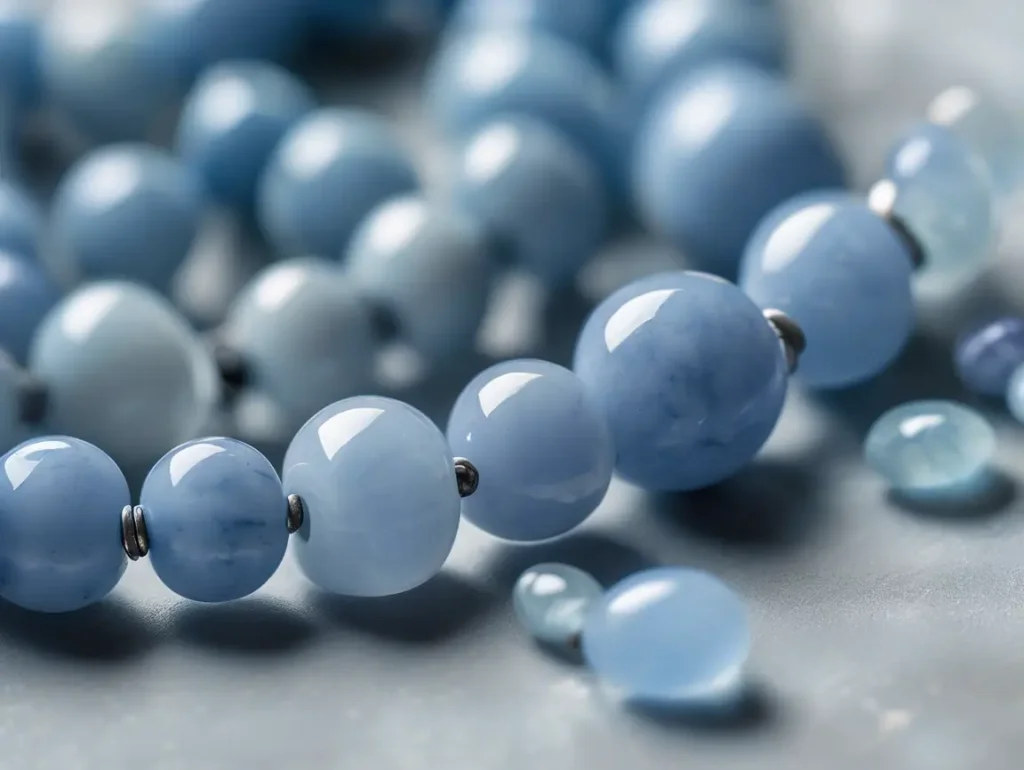
When people search for Celestite vs Angelite, they’re often not just confused by looks but by names. Crystal names are full of poetry, branding, and regional slang, which can make things tricky for newcomers and even seasoned collectors. Angelite and celestite are no exception. Both go by different names depending on who you ask, where you shop, or what you believe.
When people search for Celestite vs Angelite, they’re often not just confused by looks but by names. Crystal names are full of poetry, branding, and regional slang, which can make things tricky for newcomers and even seasoned collectors. Angelite and celestite are no exception. Both go by different names depending on who you ask, where you shop, or what you believe.
Celestite vs Celestine: Two Names for the Same Stone
Let’s clear this up first: Celestite and celestine are the same mineral. The term “celestine” is the official name used in geology and mineral databases, while “celestite” is the preferred name in metaphysical and jewelry circles. Both refer to strontium sulfate (SrSO₄), and both can describe the same sparkly, sky-blue crystals you find in clusters or cut into palm stones.
Some vendors will use the two names interchangeably to create the illusion of variety, but don’t be misled—they’re just offering the same mineral under slightly different branding. It’s another wrinkle in the Celestite vs Angelite comparison that buyers should be aware of.
Angelite: A Trade Name, Not a Scientific One
Angelite, on the other hand, is not a mineral name at all—it’s a trade name. Scientifically, the stone is anhydrite, a dehydrated form of gypsum (CaSO₄). In the 1980s, marketers specifically used the name “Angelite” to market blue anhydrite from Peru. Because the material looked soothing and “angelic,” metaphysical sellers quickly picked up the name—and it stuck.
Unlike celestite, angelite doesn’t have an alternate scientific synonym. If you hear names like “Blue Anhydrite,” “Peruvian Anhydrite,” or “Angel Stone,” they’re all referring to the same thing: Angelite. This trade naming convention is one reason why the Celestite vs Angelite discussion can seem confusing—one stone is rooted in science, the other in marketing.
Cultural and Historical Uses
Historically, celestite has been mined and studied since the 18th century, especially for its strontium content, which was once used in fireworks to produce red flames. People also collect it as a mineral specimen because of its striking crystal formations. Today, its main use is aesthetic and spiritual—display clusters, meditation stones, and decor.
Angelite, on the other hand, has no long geological history in popular use—it entered the market relatively recently. The growing popularity of crystal healing, yoga, and spiritual wellness directly contributes to its rise. People embraced Angelite for its calming presence and soft blue color, believing it to connect users with angelic guidance—hence its name.
Although Angelite doesn’t sparkle or form fancy crystals like Celestite, it has become a favorite material for making beads, worry stones, and figurines because of its soft uniformity and ease of carving. This stark contrast in history and material behavior deepens the divide in the Celestite vs Angelite conversation.
Metaphysical Profiles and Zodiac Ties
When it comes to energy and intention, Celestite vs Angelite reveals even more divergence. Both stones are said to connect to higher realms—but in different ways.
- Celestite is often described as a stone of divine communication. It’s linked to mental clarity, angelic presence, and even channeling. Those seeking peaceful sleep, spiritual insight, or guidance during meditation favor it. Angelite pairs best with the signs of Gemini, Taurus, Libra, and Pisces.
- Angelite is more of a heart-soother. Angelite, also associated with the spiritual realm, is believed to ground its energy in empathy, compassion, and emotional healing. It supports communication, but more on a soul-to-soul level. It resonates well with Cancer, Scorpio, Aquarius, and Sagittarius.
Both stones align with the throat chakra, which governs communication—but celestite is considered more “celestial” in tone, while angelite is more “personal” and emotionally supportive.
The Language of Energy: Clarity vs Comfort
To put it simply:
- Celestite speaks like a teacher—clear, luminous, and elevated.
- Angelite speaks like a friend—gentle, calm, and steady.
This emotional language helps explain why so many people are drawn to one over the other. When choosing between Celestite vs Angelite, it’s worth tuning into how you want your space—or your spirit—to feel. Are you looking for cosmic insight? Or do you just need a quiet hug after a long day?
What Crystals Are Similar to Celestite? Deep-Dive Comparisons
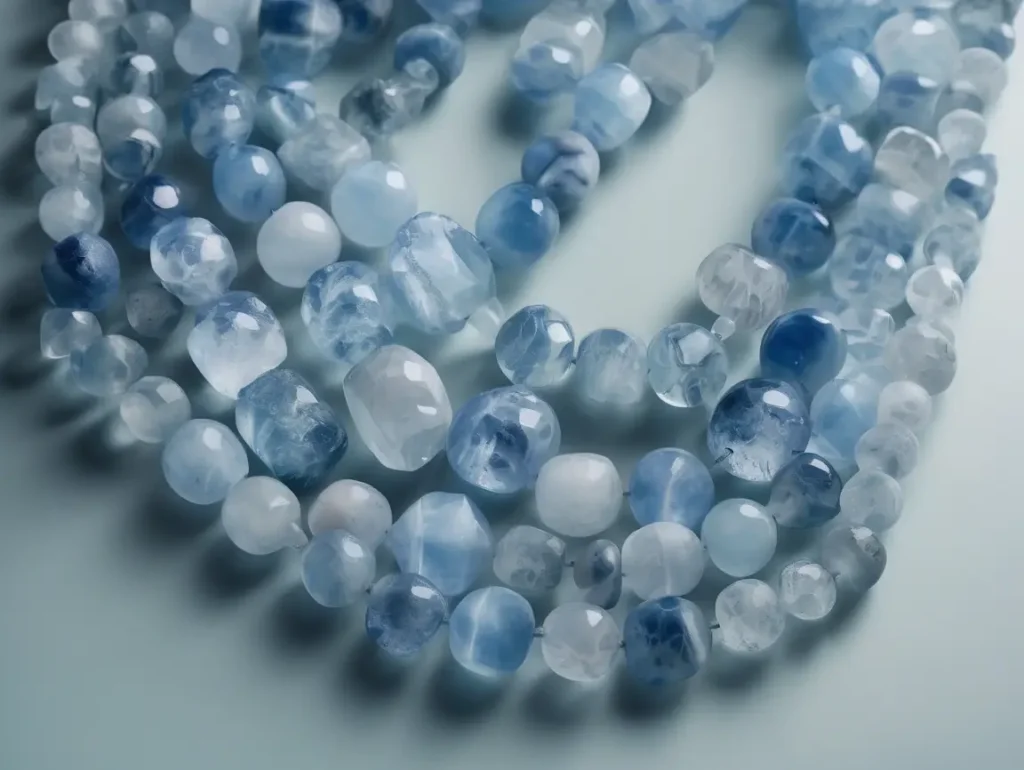
Blue crystals often attract the same kind of emotional attention: serenity, openness, and clarity. But when buyers are comparing Celestite vs Angelite, they’re rarely just considering those two—they’re also weighing similar stones like blue calcite, sodalite, and even aquamarine. In this segment, we’ll walk through how celestite stacks up not only against angelite but also against its “blue-hued cousins” in both look and energy.
Celestite vs Blue Calcite: The Common Misidentification
One of the most common confusions occurs between celestite and blue calcite. Both can appear in sky-blue to icy-blue shades, but they behave very differently under light and touch. Celestite has a glassy, almost watery luster, while blue calcite has a waxy or cloudy finish, sometimes with fibrous textures that run across the surface.
In terms of metaphysical feel, celestite brings an “above the head” kind of clarity—thoughts sharpen, breath slows, and the room feels lighter. Blue calcite, on the other hand, often settles into the body like a warm compress, relieving emotional heaviness and promoting recovery. So when someone asks whether blue calcite is the same as celestite, the answer is clear: no—and the differences in both energy and appearance make that easy to confirm once you’ve held them.
Celestite vs Blue Celestite: Natural Grading and Color Ranges
Another subtle distinction worth noting is the difference between bright blue celestite and its paler, sometimes colorless variants. Some people label the deeper shades as “blue celestite” and the lighter ones simply as “celestite,” but this is a naming preference—not a mineralogical distinction.
Natural celestite varies in color based on location and strontium concentration. Madagascar celestite tends to have the richest blue saturation, while Mexican or Iranian deposits often show more gray or white tones. Unlike Angelite, Celestite’s transparency can range from glass-clear to barely translucent, offering more depth and sparkle for collectors who enjoy the play of light.
This color variation adds one more angle to the Celestite vs Angelite conversation: celestite is dynamic—no two clusters look exactly alike. Angelite, in contrast, is reliably uniform. Its beauty lies in its consistency, while celestite’s charm is in its unpredictability.
Angelite vs Aquamarine, Sodalite, and More
When people can’t find Angelite, they often turn to Aquamarine, Larimar, or Sodalite for a similar blue tone. But none of these truly replicate the feel of Angelite.
- Aquamarine is beryl-based, much harder (Mohs 7.5), and more transparent. It’s typically used in fine jewelry, not for meditation or emotional grounding.
- Sodalite is deeper in tone—navy with white veining—and tied to rational thought and truth-seeking.
- Larimar, like Angelite, is soft and creamy blue, but it has volcanic origins and is mined only in the Dominican Republic.
All these stones offer beautiful benefits—but when comparing Celestite vs Angelite, the emotional terrain feels more intimate and relevant. They both carry that “lightness of being” many seekers crave, whereas harder stones like aquamarine tend to be more energizing or assertive.
What to Choose: Beads, Clusters, or Palm Stones?
Now comes the practical question: what form should you buy these stones in?
- Celestite: Best in raw clusters, geodes, or small polished palm stones. Because of its fragile crystal structure and tendency to chip, celestite is rarely sold in beads or drilled shapes. If you find celestite beads, they’re either stabilized or risky to wear daily.
- Angelite: Perfect for bead strands (4mm, 6mm, 8mm, 10mm), worry stones, spheres, or carved shapes. Its soft, massive formation makes it ideal for round jewelry without breakage concerns.
If you’re making jewelry, Angelite wins. If you’re decorating a sacred space or using stones for altar work, celestite is likely the better option. This form-based practicality further solidifies the Celestite vs Angelite divide—not just in energy, but in use case.
Crystal Collector Tip: Go Beyond Looks
Blue isn’t just blue. Whether you’re looking for celestite’s shimmering lightness or angelite’s velvety calm, it helps to look beyond the surface. Ask yourself, do I need clarity or comfort? Are you seeking radiance or reassurance?
While many crystals mimic the color palette, few deliver the same emotional signature. That’s why people continue asking about Celestite vs Angelite even after decades of both stones being on the market—it’s not just about what they are, but how they feel.
Practical Lessons from Living with Celestite vs Angelite
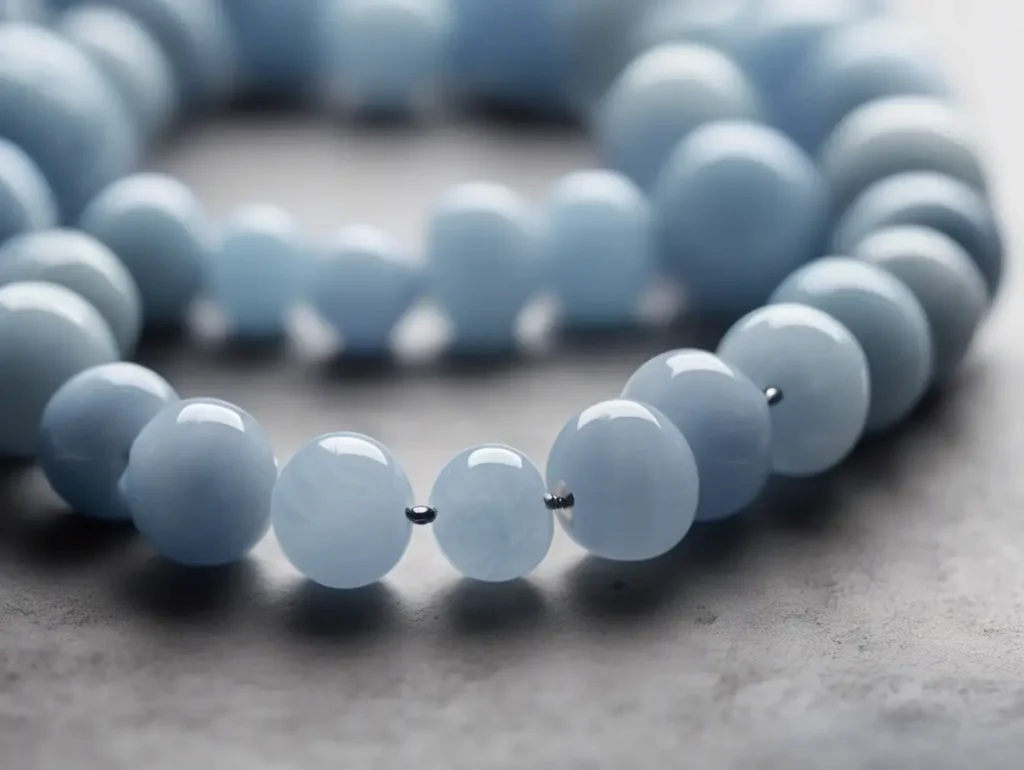
I’ve kept a Celestite vs Angelite pair on my desk for years, and they’ve taught me more about patience than any productivity podcast. Here are the lessons I’ve acquired through personal experience, presented in straightforward language, free from the formality of a “crystal-care manual” tone that often comes across as overly polished.
Sunlight? A Short Morning Stroll—Nothing More
One summer I left my geode in a sunny window because the blue looked gorgeous against the curtains. Three weeks later, the top layer had faded to a washed-out gray. The Angelite sphere next to it fared no better; a chalky haze crept across its surface. Moral of the story? If you’re comparing Celestite vs Angelite for a bright windowsill, pick neither. If you need to “charge” them, give the stones an hour of gentle dawn light, and then return them to indirect shade.
Water and These Stones Do Not Get along.
A friend once tried the TikTok “moon-water cleanse” with her Angelite bracelet. By morning each bead carried tiny white spots like freckles. Celestite isn’t any braver—it dissolves grain by grain if you rinse it under the tap. Keep a lint-free cloth nearby and call it good. The less fuss you make, the longer the Celestite vs Angelite glow lasts.
Choosing Their Best Form—Jewelry or Décor
Celestite clusters remind me of frozen waves; I place one on a bookshelf where the afternoon light skims across the points. Wearing celestite, though? I gave up after a bead cracked while I tied a knot. In the Celestite vs Angelite debate, angelite wins hands-down for bracelets and necklaces. Its massive structure means a 6 mm round bead survives a busy commute, grocery bags, and the occasional doorframe bump. Celestite stays home, safe and sparkling.
Packing for a Trip: Lessons Learned in Airport Security
If you ever fly with crystals, wrap them like pastries from a fancy bakery. Bubble wrap looks silly but saves heartbreak. I once slid both stones into the same velvet pouch; turbulence chipped a celestite edge and left blue dust on the angelite. Now I layer cotton rounds between pieces. That extra minute makes the whole Celestite vs Angelite collection land intact.
Sleep and Meditation—A Quick Reality Check
Blogs love to promise cosmic dreams, yet sleeping with a fragile stone under your pillow is a recipe for crumbs in the sheets. I park Celestite on the nightstand instead; its faint shimmer catches the reading lamp and signals “time to slow down.” Angelite rests near my water glass—close enough to touch during a late-night worry spiral but far from any accidental splash. Taken together, this quiet Celestite vs Angelite setup feels like a small, nightly ritual of clarity and comfort.
Everyday Cleaning—Keep It Boring, Keep It Safe
Skip the essential-oil sprays, the salt baths, and the tumble of rice grains. A soft brush once a month removes desk dust; a gentle breath polishes the points. That’s it. The simpler the routine, the less chance you’ll chip a crystal or stain a bead. Remember, the whole point of owning Celestite vs Angelite isn’t to babysit them; it’s to let them sit there and remind you to breathe.
Why Gentle Care Matters Beyond Perfect Shine
These stones break easily, and yes, that can be annoying. But their fragility mirrors the qualities they’re supposed to encourage: calm, empathy, and a lighter touch with the world. Each time I slow down to move the Celestite vs Angelite duo out of direct sun or wipe away a film of dust, I practice the patience they symbolize. And on hectic days, that small pause feels more valuable than the prettiest sparkle.
FAQ: Common Questions About Celestite vs Angelite
Are Angelite and Celestite the same thing?
No, they are not the same. While their colors are similar, their chemical composition, formation process, and physical structure are completely different. Celestite is strontium sulfate, while Angelite is calcium sulfate in its anhydrite form. If you’re choosing between Celestite vs Angelite, this difference in makeup should be your first clue—they’re not interchangeable.
Is Angelite compressed Celestite?
This is a myth. Angelite is not a compressed version of Celestite. The two form in entirely different geological conditions. Celestite forms in marine sedimentary rocks, while Angelite forms through the dehydration of gypsum in evaporite deposits. In short, Celestite vs Angelite isn’t a before-and-after story—it’s a side-by-side comparison of two unrelated minerals.
What is another name for Angelite crystal?
Angelite is actually a trade name for blue Anhydrite. Scientifically, there is no other official name, but some sellers may call it “Blue Anhydrite” or “Peruvian Anhydrite.” Unlike Celestite, which also goes by Celestine, Angelite has no formal mineralogical alias.
What is another name for Celestite?
Celestite is also known as Celestine—both names refer to the same mineral: strontium sulfate. Whether you’re shopping online or browsing a gem show, it’s helpful to know that Celestite and Celestine are just two sides of the same label.
What crystals are similar to Celestite?
In terms of color, Blue Calcite, Aquamarine, and Larimar are often mistaken for Celestite. However, they all differ in transparency, luster, and hardness. Celestite has a distinct sparkle and clarity that sets it apart. If you’re torn between Celestite vs Angelite, and find yourself looking at other blue stones too, remember—none of them quite match either stone’s unique softness and energy.
Is Blue Calcite the same as Celestite?
No, Blue Calcite is softer and has a more waxy, cloudy appearance compared to Celestite’s bright, glassy transparency. The energy is different too—Celestite feels expansive and crisp, while Blue Calcite feels internal and soothing. Comparing Celestite vs Angelite is already complex; adding Blue Calcite to the mix only deepens the nuance.
Are Selenite and Celestite the same?
They’re not. Selenite is a form of gypsum, whereas Celestite is strontium-based. However, because both can be white or translucent, they’re sometimes confused. If you’re building a collection and you see a low-cost “Celestite” that feels like chalk—it may actually be mislabeled Selenite.
What is the scientific name for Celestite?
The scientific name is strontium sulfate (SrSO₄). Its crystal system is orthorhombic, and it forms transparent to translucent crystals in sedimentary rocks. In gem shops, it’s usually sold as “Celestite” or “Celestine.”
Can you sleep with Angelite under your pillow?
You can, but it’s not ideal. Angelite is soft and can scratch, dent, or rehydrate with body moisture. Instead, place it on your nightstand or under your bed. The same goes for Celestite—it’s even more fragile and better off resting nearby rather than on your pillow. In any Celestite vs Angelite bedtime setup, safety and placement matter.
Conclusion: Celestite vs Angelite—Clarity or Comfort, Which Do You Need?
By now, you’ve probably realized that the Celestite vs Angelite question doesn’t have a “better” or “worse” answer. It’s not about ranking one above the other—it’s about understanding what each stone offers and recognizing which energy fits your moment, your space, or your spirit.
Celestite sparkles with light and speaks of elevation. It’s the stone you reach for when you need clarity, insight, or to reconnect with your higher self. Its fragility reminds you to slow down, to listen, and to protect what’s precious—even in yourself.
Angelite, by contrast, doesn’t sparkle—it soothes. Its matte surface feels like soft conversation, like a deep breath after an emotional wave. It’s grounding, emotionally supportive, and ideal when your life feels noisy and you crave internal calm.
So how do you choose?
- Want to create a peaceful altar or sacred space that catches light? Go with celestite.
- Are you in search of a bracelet that provides comfort during challenging times? Angelite is your quiet ally.
- Do you require both clarity and compassion? You might find that these two work better together than apart.
Their shared softness makes them easy to overlook in favor of flashier stones—but those who connect with them often keep them close for years. That says something. They don’t just offer energy; they invite you to handle life with more care.
Ultimately, Celestite vs Angelite isn’t a competition. It’s a conversation. This conversation takes place between the sky and the sea, the mind and the heart, and the vision and the stillness. And when you listen closely, you’ll know which voice you need right now.

